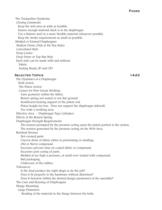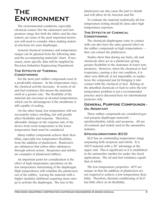
Catalog excerpts

Since 1986 Precision Industries hasbeen creating solutions to complex engi-neering questions.Precision has designed and manufac-tured millions of diaphragms. Ourdiaphragms are used in sophisticated tech-nologies as well as basic applications.As the diaphragm design specialists,Precision Industries has prepared thismanual to help you develop a greaterunderstanding of the unique aspects ofdiaphragm design and their uses. It doesnot replace our creative engineering staff. With the combined experience of morethan 60 years of diaphragm engineering,our staff is dedicated to helping solvedesign problems, one diaphragm at a time.We thrive on challenge, call us. > ISO 9002 REGISTERED Precision Industries Corporation 6115 West Executive Drive 105 North Mequon, WI 53092414-238-5000 FAX414-238-5010 E-Mail glennt@prec > - ind.com >
Open the catalog to page 1
Pages Selected Topics14-23 The Trampoline SyndromeClosing CommentsKeep the web area as wide as feasible. Ensure enough material slack is in the diaphragm. Use a thinner and/or a more flexible material whenever possible. Keep the stroke requirements as small as possible.Molded or Formed DiaphragmsShallow Draw, Dish or Pie Pan Styles Convoluted Style Drop Center Deep Draw or Top Hat Style Each style can be made with and withoutFabric Sealing Beads, ID and OD The Dynamics of a DiaphragmWall ActionThe Piston Action Causes for Non-Linear StrokingYarn geometry within the fabric. Return spring not...
Open the catalog to page 4
Pages Distortion of the flange material around the bolt holes.Nonparallel Flanges (Cocking or Warpage) Surface Roughness.Flange Sealing With BeadsBead & Groove Design Bead profileProvides for a more even draw of the fabric onto the diaphragm. While smoothingout possible wrinkles, it also aids in keeping the fabric in place within the part.Provides for a positive location of the part in the trim die, which controls the concentricity. Provides for back pressure in the mold to allow positive flow of the rubber and flushes out trapped gasses in the bead.Determining The Size of the Piston...
Open the catalog to page 5
Initial Considerations Diaphragms come in many forms and aremade from a wide variety of materials. This manual covers only those diaphragms made from elastomers, polymers with rubber-like properties, and/or a natural or synthetic rein- forcing material. Selecting the right material for the need is only part of the equation. The diaphragms shape and manufacturing process are equally important. > There are basic questions toanswer whenever a diaphragm isbeing designed. Before you begin,ask the following: A Bit Of History Diaphragms, gaskets and seals have been withus for centuries. Before the...
Open the catalog to page 6
precision industries corporation diaphragm engineering & design manual 2 >
Open the catalog to page 7
Precision Industries Corporation Diaphragm Engineering & Design Manual Environmental conditions, especial-ly chemical contact (for the elas-tomer) and temperature range (forboth the fabric and the elastomer),are some of the most important fac-tors you will need to consider whenmaking material selections for yourdiaphragm. This section outlines materialsused in diaphragm constructionand the advantages of each. >
Open the catalog to page 8
The Effects of ChemicalConditioning The chemicals diaphragms come in contactwith can also have the same general effect on the rubber compounds as high temperatures they can extract the plasticizers.Studies show that during use fuels, oils andchemicals often act as a plasticizer, giving greater flexibility to the elastomer at lower tem- peratures. However, when the chemical or fuel evaporates, causing a dry-out condition, it is often very difficult, if not impossible, to replas- ticize the compound just by bringing it into contact with the chemical or fuel. Relying on the absorbed chemicals...
Open the catalog to page 9
Silicone Silicone is often used when a broad tempera-ture range is expected. It has natural low tem- perature flexibility and does not require the addition of plasticizers. Silicone is not fuel or oil resistant, however, it does exhibit moderate chemical resistance. It can be compounded for low hysteresis (low rolling resistance) where exceptionally flexible diaphragms are required. Silicone is usually furnished colored as it does not require carbon black for reinforcement. mounts, pads, isolators and so forth. Fluorosilicone Fluorocarbon This material has many desirable propertieswith the...
Open the catalog to page 12
Precision Industries Corporation Diaphragm Engineering & Design Manual Coated Fabrics Thin sensitive cross-sectionsTwo-side coating protects fabric from attack and wear Two-side coating can withstand pressure reversalsBalance coating Lower tooling costs Excellent laminating capability Flat cutsHigher Adhesion Between Rubber & FabricDeep draw capabilitiesMaterial available in small lots Excellent bead & feature formation Typically lower piece pricingCosts of parts can be higher for lowvolume parts.Availability of materials Minimum material runs Limited coating thickness can reduce bead and...
Open the catalog to page 15
Thicker Isnt Always Better ғIf a little is good, a lot must be better! Wellnot always, and especially not when it comes to diaphragm thickness. Many engineers have tried to overcome high pressure by adding more thickness. This is especially true with non-rein- forced diaphragms and diaphragms used in some pumps.While it may be advisable to use a thickerproduct in some applications, the design rule is, ԓas thin as safely possible. Thinner diaphragms roll easier as less energy is absorbed resulting in a lower hysteresis. The more rolling resistance your diaphragm sees, the greater the...
Open the catalog to page 16
this style of diaphragm. A Quick Guide to Determining Which Styleof Diaphragm Is Right For Your Application > When to Use A Flat Diaphragm Flat Diaphragms Many factors determine if a flat diaphragm ispractical. First is the stroke requirements of the application. Flat diaphragms do not have long stroke capability. Depending on size, rein- forced flat diaphragm stroke capabilities may range from a few thousandths of an inch to not much more than an inch. Non-reinforced ver- sions may be somewhat greater due to their ability to stretch. In fact, for a flat diaphragm to function properly it...
Open the catalog to page 17All Simrit catalogs and technical brochures
-
Merkel U-Ring Seal Set 0217
1 Pages
-
Merkel U-Ring Seal Set 0214
2 Pages
-
Radiamatic HTS II
4 Pages
-
Simmerring® MROToolkit
4 Pages
-
Industrial Standard O-Ring
70 Pages
-
HTS II Typ 9535
1 Pages
-
SF5
1 Pages
-
FKM
1 Pages
-
Simmerring BAUM.../SL
2 Pages
-
Simmerring B2.../SL
2 Pages
-
Simmerring B1.../SL
2 Pages
-
Simmerring B2PT
1 Pages
-
Simmerring MSS 1
1 Pages
-
Custom-Made SURFACES
20 Pages
-
Catalogue 2007 Vibration Control
131 Pages
-
Catalogue 2007 Pneumatics
93 Pages
-
Floating Seals, ES Series brochure
12 Pages
-
Gasket brochure
4 Pages
























